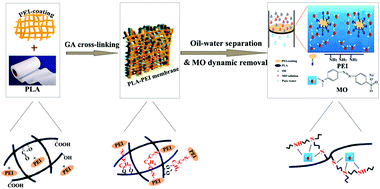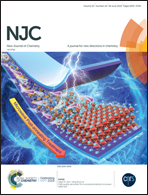Functionalization of biodegradable PLA nonwoven fabrics as super-wetting membranes for simultaneous efficient dye and oil/water separation†
Abstract
Although the construction process of dual functional materials for dye and oil/water separation has been developed rapidly, the postprocess of the used separation materials themselves is still a problem owing to their non-degradation in the natural environment. Herein, novel porous membranes (PLA–PEI) are successfully prepared based on the utilization of a dip-coating technique. The adsorption isotherms and kinetics present a good correlation with Langmuir isotherms and the pseudo-second-order model, respectively. The maximum adsorption capacity of PLA–PEI for methyl orange (MO) can reach 455.10 mg g−1, which is approximately 78 times as much as that of PLA (5.82 mg g−1). In addition, the separation efficiencies of three actual oils (methylbenzene, hexamethylene and soybean oil) are all higher than 99.7%. Moreover, the obtained membranes can realize high-efficiency and simultaneous removal of MO (removal efficiency > 99.8%) and oil droplets (oil rejection > 99.7%) from mixed wastewater under a permeate flux of up to 8285 L m−2 h−1 solely driven by gravity. These results suggest that PLA–PEI is a promising and competitive candidate for water purification.



 Please wait while we load your content...
Please wait while we load your content...